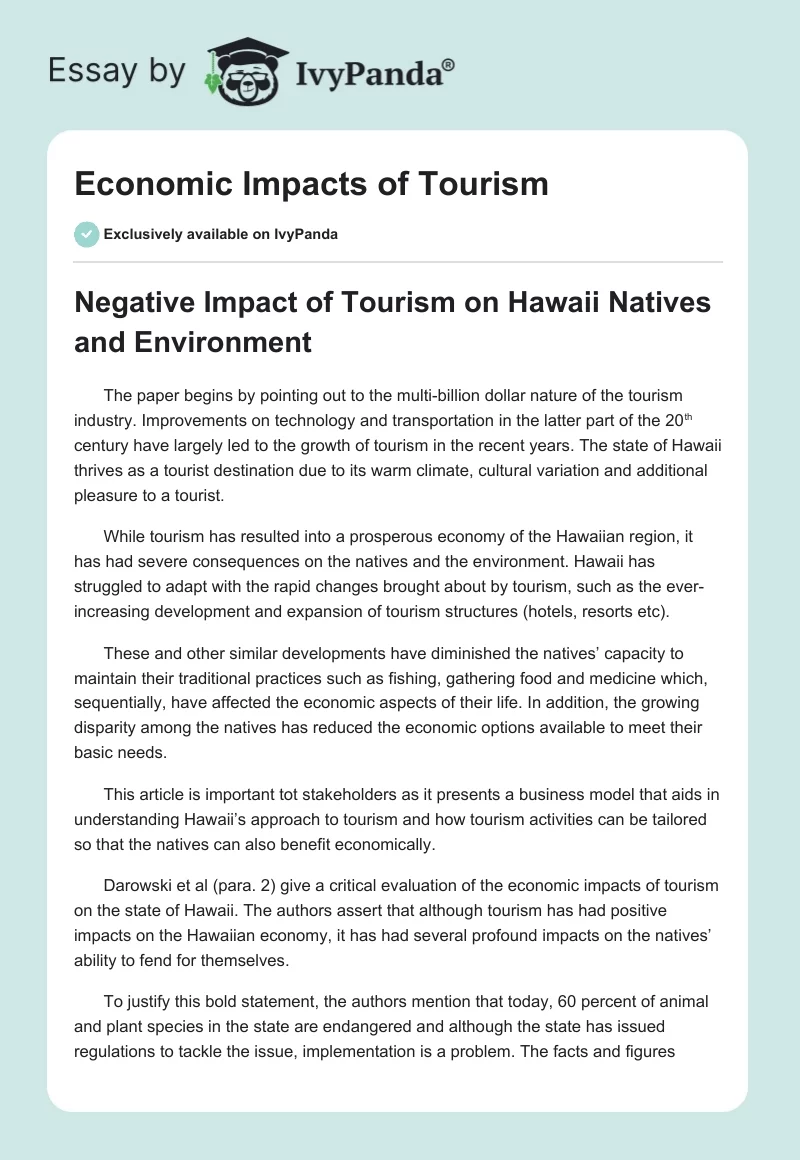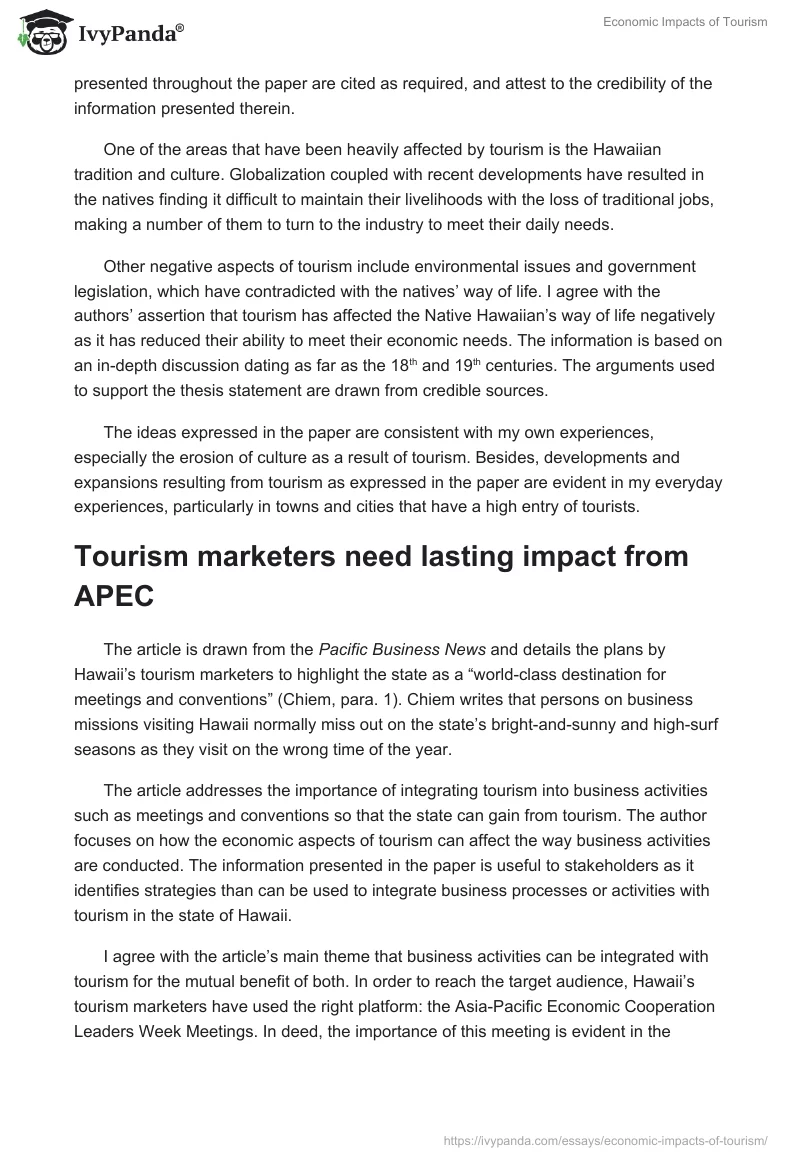Negative Impact of Tourism on Hawaii Natives and Environment
The paper begins by pointing out to the multi-billion dollar nature of the tourism industry. Improvements on technology and transportation in the latter part of the 20th century have largely led to the growth of tourism in the recent years. The state of Hawaii thrives as a tourist destination due to its warm climate, cultural variation and additional pleasure to a tourist.
While tourism has resulted into a prosperous economy of the Hawaiian region, it has had severe consequences on the natives and the environment. Hawaii has struggled to adapt with the rapid changes brought about by tourism, such as the ever-increasing development and expansion of tourism structures (hotels, resorts etc).
These and other similar developments have diminished the natives’ capacity to maintain their traditional practices such as fishing, gathering food and medicine which, sequentially, have affected the economic aspects of their life. In addition, the growing disparity among the natives has reduced the economic options available to meet their basic needs.
This article is important tot stakeholders as it presents a business model that aids in understanding Hawaii’s approach to tourism and how tourism activities can be tailored so that the natives can also benefit economically.
Darowski et al (para. 2) give a critical evaluation of the economic impacts of tourism on the state of Hawaii. The authors assert that although tourism has had positive impacts on the Hawaiian economy, it has had several profound impacts on the natives’ ability to fend for themselves.
To justify this bold statement, the authors mention that today, 60 percent of animal and plant species in the state are endangered and although the state has issued regulations to tackle the issue, implementation is a problem. The facts and figures presented throughout the paper are cited as required, and attest to the credibility of the information presented therein.
One of the areas that have been heavily affected by tourism is the Hawaiian tradition and culture. Globalization coupled with recent developments have resulted in the natives finding it difficult to maintain their livelihoods with the loss of traditional jobs, making a number of them to turn to the industry to meet their daily needs.
Other negative aspects of tourism include environmental issues and government legislation, which have contradicted with the natives’ way of life. I agree with the authors’ assertion that tourism has affected the Native Hawaiian’s way of life negatively as it has reduced their ability to meet their economic needs. The information is based on an in-depth discussion dating as far as the 18th and 19th centuries. The arguments used to support the thesis statement are drawn from credible sources.
The ideas expressed in the paper are consistent with my own experiences, especially the erosion of culture as a result of tourism. Besides, developments and expansions resulting from tourism as expressed in the paper are evident in my everyday experiences, particularly in towns and cities that have a high entry of tourists.
Tourism marketers need lasting impact from APEC
The article is drawn from the Pacific Business News and details the plans by Hawaii’s tourism marketers to highlight the state as a “world-class destination for meetings and conventions” (Chiem, para. 1). Chiem writes that persons on business missions visiting Hawaii normally miss out on the state’s bright-and-sunny and high-surf seasons as they visit on the wrong time of the year.
The article addresses the importance of integrating tourism into business activities such as meetings and conventions so that the state can gain from tourism. The author focuses on how the economic aspects of tourism can affect the way business activities are conducted. The information presented in the paper is useful to stakeholders as it identifies strategies than can be used to integrate business processes or activities with tourism in the state of Hawaii.
I agree with the article’s main theme that business activities can be integrated with tourism for the mutual benefit of both. In order to reach the target audience, Hawaii’s tourism marketers have used the right platform: the Asia-Pacific Economic Cooperation Leaders Week Meetings. In deed, the importance of this meeting is evident in the marketer’s reference to it as “the most important business convention in state history” (Chiem, para. 1).
Such a platform would enable them to reach their target audience, including company executives and businesspersons who could be convinced to visit Hawaii for business meetings and conventions during seasons that coincide with the bright-and-sunny or high-surf seasons. David Uchiyama, one of the leading members of the Hawaii Tourism Authority, points out to another element that can be used to promote tourism in Hawaii among the international business community; incentives.
I am in agreement with the plan as it is consistent with my experiences and the general perception regarding the role of incentives in business. Incentives would encourage business travelers not only to visit Hawaii, but to visit it during the season mentioned above and thus enjoy the cool weather of the island and, in return, increase Hawaii’s revenues from tourism. This plan, if successful, could generate numerous economic advantages to the state.
Estimating economic impacts from tourism
This paper compares two models, computable general equilibrium (CGE) and the input-output (IO) approach, used in examining the effects of tourism on the economy of an area.
The CGE model is a relatively new analytic technique that is in its early stages of use. After the comparison, the authors use the two models to analyze the impacts of a drop in visitor expenditure on Hawaii’s economy (Zhou et al, pp. 76).
Hawaii’s expenditure is mainly based on tourist spending, defense expenditure, and sugar sales. Spending by tourists has risen steadily over the decades and accounted for nearly 35 per cent of the state’s Gross State Product (GSP) in 1997.
From the analysis, the authors observe that segments of the economy related to tourism show the largest effects, hence pointing out to the economic significance of tourism to Hawaii. The research paper is important to practitioners in planning and implementing strategies for improving tourism in the state of Hawaii to improve its GSP values.
Being a research/scholarly paper, the authors have used a number of references to support their arguments on the economic impacts of tourism in the state of Hawaii. Zhou et al write that the growth of the tourism sector has steadily transformed the structure of Hawaii’s economy mainly in four areas.
First, Hawaii’s export industry has been transformed from agriculture-based exports to service-based exports. Second, growth in the service sector and decline in agriculture have re-shaped employment opportunities and skill requirements. Third, tax collected by the state and local governments has increased leading to improved public services delivery.
Lastly, as the service sector widens and pull is more labour, construction and complementary industries also realize increases in final product demands. The authors provide statistical evidences and tables to show proof of the transformations in the Hawaii’s economy resulting from tourism. Hence, I am in agreement with the authors’ arguments and, as a result, the findings.
The research findings of a 10 per cent drop in visitor numbers has the expected negative impacts in sectors that depend significantly on tourism, namely hotel, transportation, and eating and drinking industries.
These findings are consistent with my own experiences in daily life, for instance, a shortage in the supply or increase in the costs of fuel often transforms the industries that depend on this products with some of them looking for alternative sources of fuel while others reduce the scale of their operations. The paper is credible and I agree with the authors’ arguments regarding their findings.
Tourism management: analysis, behaviour and strategy
In Chapter 3 of Tourism management: analysis, behaviour and strategy, Woodside (pp. 87) reports on the history of tourism trends in the state of Hawaii, including the benefits and costs. Hawaii’s economy shows considerable comovement between the number of tourists and income and employment.
Tourism has its most immediate impact on gross state product, followed in a few months by the per capita income of the inhabitants. Kauai and Oahu, the largest and third largest of the islands that make up Hawaii respectively, are the most vulnerable to tourism trends in the state.
However, Maui, the second largest of the islands, is correlated with agricultural shocks while the Big Island varies most strongly with revenue from federal government employment. Generally, the economic effect of tourism in the eight islands making up the island is so immense. The information presented in the book is useful to stakeholders in planning and implementing strategies for coping with fluctuations in the number of tourists in the individual islands of Hawaii.
In this chapter, Woodside focuses on the importance of tourism as a driver of economic activity in Hawaii, and the effect that fluctuations in tourist numbers has had on the economic performance of the island over the years, with special focus on island-by-island analysis.
This chapter takes a time series approach to the relationship between tourism and the economy and examines the sensitivity of the Hawaiian economy to fluctuations in tourism numbers.
In the course of the discussion, Woodside mentions the sensitivity of the Hawaiian economy to tourism trends and how these effects impact on other sectors of the state’s economy not necessarily related to tourism, a domino effect kind of relation. Woodside’s arguments are similar to those expressed by other authors included in this paper, particularly on the importance of tourism to Hawaii’s economy.
Of particular interest in Woodside’s argument is the comovement of tourism, income, and employment in Hawaii. All three measures of Hawaii’s economy commove most strongly with fluctuations in the volume of tourists visiting the state, a factor that is reflected in the state’s figures for the Gross State Product (GSP) over the years covered by the author.
These figures are a precise pointer to the economic impacts of tourism in any town, city or state that depends significantly on earnings derived from tourism. Since the arguments are justified with numerical evidence from previous records, I am in agreement with this chapter.
Works Cited
Chiem, Linda. Tourism marketers need lasting impact from APEC. Pacific Business News, September 29. 2011. Web.
Darowski, Lukasz, et al. Negative Impact of Tourism on Hawaii Natives and Environment. Lethbridge Undergraduate Research Journal, Volume 1 Number 2, 2006. Web.
Woodside, Arch G. Tourism management: analysis, behaviour and strategy. Oxfordshire: CAB Iinternational, 2008.
Zhou, Deying, et al. Estimating economic impacts from tourism. Annals of Tourism Research, Volume: 24, Issue: 1, 1997, Pages: 76-89.


